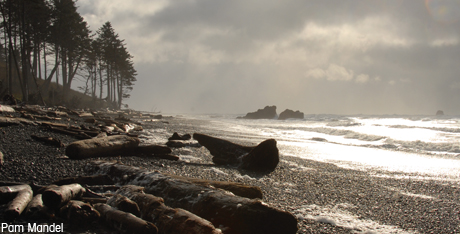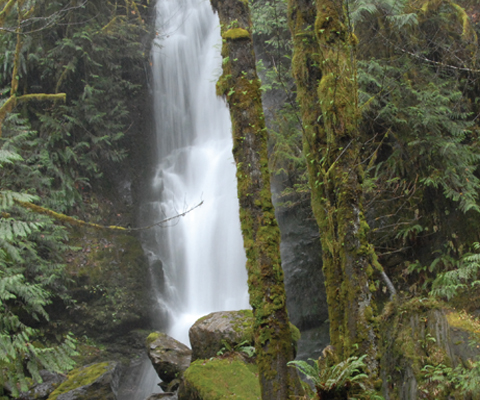I made my first visit to the Olympic Peninsula alone. My divorce papers came through that winter, and I had just turned 30. During that visit, I pitched my backpacker’s tent under the skyscraper trees and vanished into a rain storm. Holed up with a copy of Mark Twain’s “Life on the Mississippi” and just enough of a buzz to turn the noise of the rain on the tent fly into a soundtrack, I found solitude, a place where edges blur, a sense of timelessness. I woke up to a blue sky and the feeling that all the painful changes of the previous year no longer mattered.
It was 1995, my first summer in Seattle. Dennis, the floor manager at the art supply store where I fielded calls from angry and high maintenance customers, told me about the national park: “You drive past fields of stumps and clear cuts and then, just past the sign that marks the entrance to the park, the trees change. It’s like there are giant green velvet theater curtains hanging from the sky.”
We were lost in heaven, a place with no edges.
That’s where the Olympic rainforest begins, at those velvet curtains. Once inside, trees scrape the clouds with green-black needles or lightningcharred spikes. In the forest, everything becomes dense with life, the spongy ground, the fallen snags. A square inch of reddish bark supports a microcosm of the entire ecosystem — moss and mushrooms and the tiniest of white bell-shaped flowers and feathery little seedlings of future cedar giants. In pouring rain, the forest drips only the water that sneaks through the dense canopy overhead. In bright sunshine, the sun squeezes in only through places where time and weather have opened a window. A soft light comes from the ground, radiating upwards, daylight absorbed and then released back into the sky.
I try to get to the Olympic Peninsula once a year, at least; I always make more effort if I have friends visiting from far away. A friend from Germany was so enchanted with Maple Glade, a moss-covered patch of forest on the north side of Lake Quinault, she declared that landscapes like the Olympic Peninsula are the reason people believe in fairies. On that same trip, we went to the beach, parked on the sand, and disappeared into a dense fog. People materialized in front of us with no notice, parents with small children, beachcombers walking their dogs. When we turned around to face inland, we could not see the car. We were lost in heaven, a place with no edges.
When I fell in love again, I drove my new husband out to the Olympic Peninsula … Here, fences are a mere suggestion, an absurd effort at containment in a place where nothing is held in.
When I fell in love again, I borrowed a car and drove my new husband out to the Olympic Peninsula to show him what home looked like to me: a wild ocean, a forest of complete excess, all opposites of his neatly fenced homeland in rural Austria. On this western frontier, the gray-brown edge of the land meets the gray-green edge of the water meets the gray-blue edge of the sky. The trees reach up to unimaginable heights; the Pacific stretches west until it drops over the curve of the planet. Here, fences are a mere suggestion, an absurd effort at containment in a place where nothing is held in.
One spring, on a solo hike up the Hoh River, I rounded a corner and came face to face with a herd of Roosevelt elk. I could have touched the nearest one on the nose, she was so close. My heart beat in my throat; I was dizzy with fear. The elk were enormous; I stood barely tall enough to reach a brown shoulder. I waited, motionless, trying not to bolt and startle them. A minute went by, or maybe it was an hour; I could not tell. Finally, those closest to me shuffled and blinked. I stepped back; they turned their tan backsides to me and wandered uphill.
Later, on that same hike, I came out of a brush-covered section of trail to find two women, sticks raised above their heads to fend me off. “The ranger said to watch out for cougars,” one said. “Didn’t you see the alert notice?” It was too early in the day; the station was closed when I’d set off. The wildlife was as big as the landscape, wildcats and brown-eyed elk and even well-meaning people on the trails could easily get the better of me.
On a recent trip to the peninsula, the weather got too big and trapped us, the husband and me, just before Thanksgiving. An Arctic storm wandered south and dropped unusual amounts of snow on both ends of the road, penning us into a 75-mile stretch of coast where the sun was brilliant and the high temperatures hovered just below freezing.
We walked and found a dead seal on the beach, her ribs exposed by decay. She was pinned under the bones of beach logs, and in a few weeks she would be indistinguishable from the driftwood that lined the sand. Time and change would take her as they were taking me. A fine funeral it would be, dissolving into this landscape, becoming gray and white, salt and sand. A generation of my own life had passed since I first stepped on to this beach. I could feel the weight of those years, but all around me it seemed as though nothing had changed.
You can mark hours by your watch, or follow the tide, as it deposits tiny pieces of polished glass and now, plastic, along with a line of sea foam, and then, hours later, takes them all away again.
Time is different on the peninsula. You can mark hours by your watch or months by the calendar, or you can let nature mark it for you. Follow the tide, for starters, as it deposits tiny pieces of polished glass and now, plastic, along with a line of sea foam, and then, hours later, takes them all away again. Stand at the base of a fallen giant, now the host for future generations of towering trees. The elk are still here, grazing in a low meadow, stopping to look up and then turning away when I cross into their territory. Moss greens the trailer homes, and the old sawmills rust into blade-sharp edges.
The years go by and I keep returning. I recognize the tree growing like the back of a chair from the seat of a spruce stump. The boardwalk in the swamp is slick with ice or maybe rain. The skunk cabbage is pungent and leafy. The moss hangs from the trees in shredded gauzy swaths. The eagles sit high in the snags and watch the beach as it is reshaped twice daily by the tide. I go back because it is the same every time: big, continually changing, continually the same. When I stand where the edge of the forest meets the Pacific and the sky, I fill my eyes with green, my lungs with the smell of the ocean. Everything is moving, everything is alive, and time does not matter.
This article first appeared in WorldHum.com.




